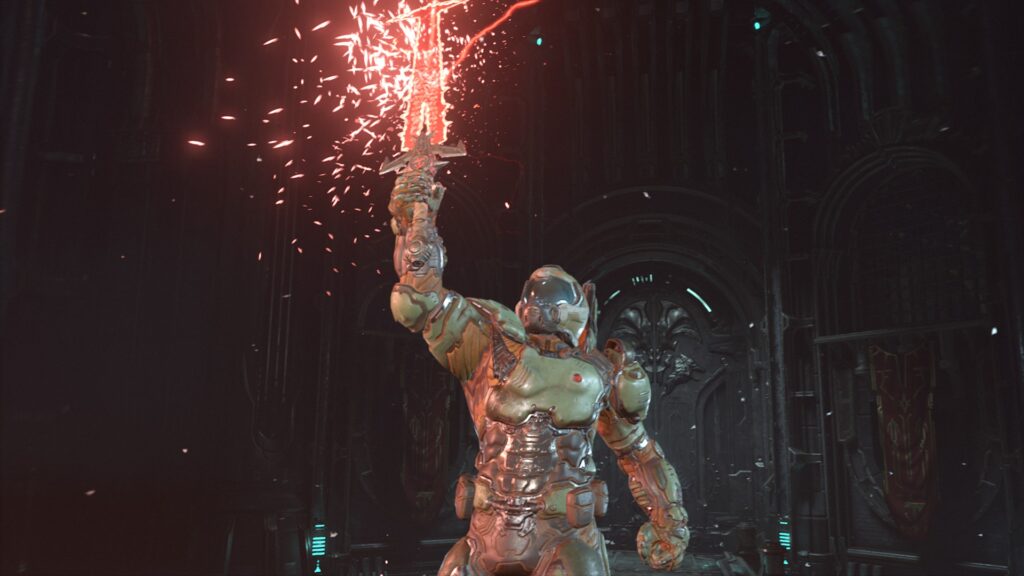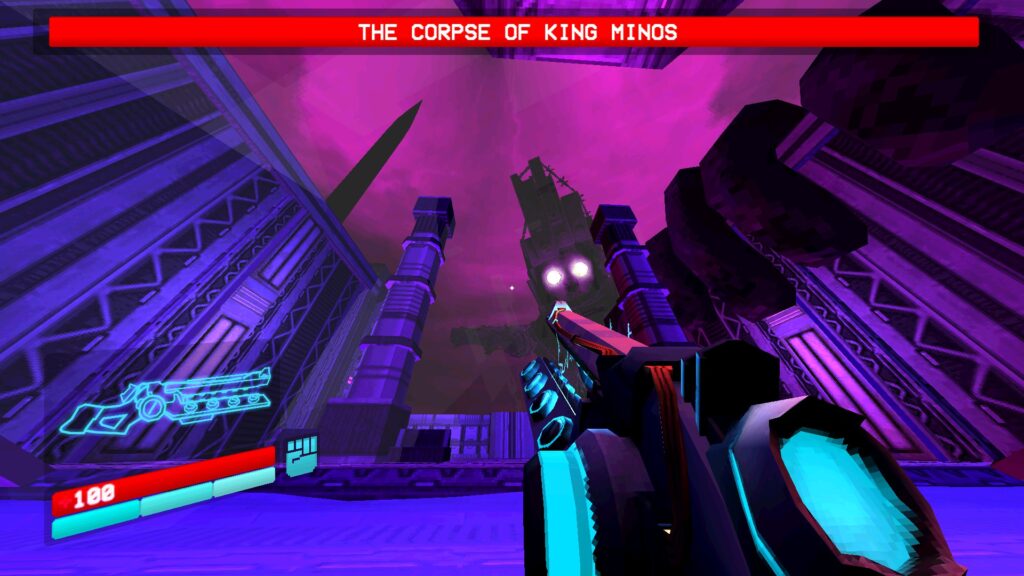Doom Eternal is one of my favorite games of the last decade, and for many of you reading this, it may be on your list, or your worst games of the 2010’s. The polarizing nature of the game comes down to a complete redesign carried from Doom 2016 with the nature of “push forward” combat. Since these games have come out, there has been this rush by other FPS designers, modern retro notwithstanding, to try and design the next elevated FPS. I’ve recently play Halo Infinite, Serious Sam, and I’m still waiting on Ultrakill to finish up. Push-forward combat is something that requires a different mentality when designing an FPS, and I want to talk about what developers are missing when it comes to it.
A Study of Ripping and Tearing
The GDC talk that id gave about Doom 2016 highlights what their mission statement was when designing the game. They didn’t want to just design another arcade FPS, or a more down-to-earth modern FPS. Their goal was to create a game where the player is always active during combat, and that meant removing anything that would either take the player out of the combat or stop them from engaging with enemies.
During the late 2000’s and into the 2010’s, AAA developers embraced the idea of regenerating health as a workaround to the healing hoarding that was a factor in many action games. The problem with this design was that to heal, the player had to remove themselves from combat and find a wall or chest-high barricade to hide behind.
While that worked for solving the healing problem, ammo hoarding was still an often-annoying part of FPS and TPS (third-person shooter) gameplay. The player can’t just unload with their best weapons, because what happens if there’s something stronger five minutes away that will kill them? Trying to play Halo Infinite was a pain for me with the number of times I kept running out of ammo in mid-fight and the two-weapon limit was not helping matters.
What id did with Doom and Doom Eternal was completely rebuild the player’s abilities, and in turn, create a new way of designing combat encounters.
One Man Utility Closet
The key to id’s push forward combat is giving the player all the utility they need to succeed. Everything that the player is going to be using in either Doom can be recovered or gained through the player’s actions. This is a complete 180 from other arcade shooters that would litter arenas with ammo packs and healing items to find or run back to.

Every weapon has its own unique utility, making sure that nothing is wasted
In Doom Eternal the player can use glory kills, the flame belcher, and the chainsaw to restore health, armor, and ammo respectively. One of the major points from the presentation was the fact that the designers never wanted the player to feel the need to stop engaging. If the player had to hide behind a wall, run away, or wait for something to recover, then that needed to be changed.
These changes also came with it the need to completely change how weapons were designed and the arenas themselves. The problem that a lot of developers who made action games faced was that they never really knew the player’s resources going from one fight to the next. Unless they purposely spawn full ammo and health beforehand, there was no way in knowing if someone was entering a fight at full reserves, or with 10 points of health left. That also meant players were punished if they used too much in a previous fight and would have to go into a new one sub-optimally or reload a save and do it all again but better.
A recent example that tried to have it both ways was Shadow Warrior 3. While the arenas did feature regenerating health and ammo pickups, the player could easily get their reserves back by killing enemies and performing finishers.
In the Dooms, the player is always going to have max resources or be able to quickly regain them during a fight. This also meant transforming the weapon designs in Doom Eternal. Shooters are often balanced and designed around the ammo capacity of each weapon — the stronger the weapon, the less ammo of it that exists. Now, if the player wanted to just fire their rocket launcher all the time, nothing would stop them from doing it, so how do you balance that?
The solution, albeit a polarizing one, was to give each weapon a specific role. Enemies could be killed faster with specific weapons, such as the arbalist for flying enemies, the shotgun’s grenades to destroy weak spots, and more. Truthfully, this does end up making games like Doom Eternal more complicated and is the opposite of the flow and pacing of other shooters. And that takes me to the one major limitation of push forward design.
The Superman Shooter
There is a classic challenge when it comes to creating compelling stories around powerful characters like Superman: how do you create a high stakes story when your main character is often the strongest character? For there to be a challenge, the player must go up against something that can either match their skills or be above it. For soulslikes, some of the most challenging and difficult battles are with enemies/bosses that mirror the player’s own abilities.
With push-forward combat, the player is the strongest character on the field, and that’s the point. As the doom guy, you’re not supposed to be fighting something that makes you feel weak. The more power you give to the player, the harder it then becomes to keep the combat interesting. In Severed Steel, no matter what the game threw at me, I had the same answer for every combat encounter. For the games that have made use of push-forward design, there have been several possible solutions, with each one having pros and cons to them.
The first one is overwhelming the player, seen in games like Doom Eternal and Ultrakill. The player must constantly juggle health/resource management, movement, and threat priority constantly. In Doom, it is not unusual to go from 100 health to 10, to back to 100 in the span of seconds. My issue with this one is that it typically creates a difficulty spike for players who can’t keep up with the pacing that these games require. Many Doom Eternal fans made use of a technique of rapidly switching between weapons to eliminate the cooldown and reload animations of their heavier weapons. For me, I could never get comfortable doing that, which also led to an increased difficulty for some of the fights.
The second one is to introduce a “rule-breaker” — an enemy or situation that breaks up the flow of combat or circumvents the player’s general abilities. Doom Eternal, of course, has this in the form of the marauders, and Ultrakill has some epic boss encounters like V2. The problem with rulebreakers is that you really need to be careful in terms of how they mess with the core gameplay loop. If your entire game is built around the player being able to health regen at will, and you create an enemy that nullifies that, it could make playing the game at those parts very frustrating.
Boss fights are often a great way to really test the limits of your systems and shows off what push-forward combat really means.
Doom Guy May Cry
Push-forward combat is, in a way, moving FPS design away from the arcade shooters and corridor-focused that dominated the market, to creating a more dynamic system akin to action games. Therefore for someone like me, games like Ultrakill and Doom Eternal feel natural, but at the same time, this is not what FPS games were originally designed for.

More indie games are experimenting with their FPS designs since Doom Eternal
The big takeaway from push-forward combat is that the player is not only the one in charge of resource management but also resupplying themselves if need be. This removes the limitation of having to fill areas with resources or stopping the gameplay to wait for resources to come back. I would like to see more developers experiment with creating interesting level designs now that the resource limitations are no longer an issue, and this is something that Ultrakill looks very promising with.
What do you think of push-forward combat? And are there other games out there that have similar design systems?
If you enjoyed this story, consider joining the Game-Wisdom discord channel. It is open to everyone.

